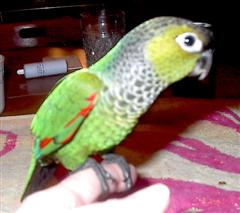Conure - Black Capped
Scientific Name: Pyrrhura rupicola rupicola
Wed, 2nd July, 2025 - 6:23 pm GMT
Sponsor Ads:

Alternative Name
Scientific Name: Pyrrhura rupicola rupicolaBasic Info
Black-capped Conures grow to about nine and a half inches in length. They usually weigh around two and a half ounces. True to their name, Black-Capped Conures have black-brown foreheads, crowns, napes and head-backs, although they are predominantly green in color. Often, the nape and head-back feathers have pale edges. The Black-Capped Conure also has a dark brown throat and upper breast, although the feathers have such broad pale edges that the upper part of the bird appears whitish and scaled. The abdomens of Black-capped Conures are tinged with various shades of red, as are the wing edges and primary coverts. The primary colors are slightly tinged with blue, and the top of the tail is green! The tail has a dark gray underside. The feet and legs of Black-capped Conures are also gray, as is the bill. The skin surrounding the periopthalmic ring is white and the iris of the Black-capped Conure is brown.
Health
In his cage, your Black-capped Conure will need a nesting box so he can retire when he feels shy or tired. He will also need lots of sturdy toys and branches to chew on so that he can be amused. Because of their extremely good chewing capability, they should be kept in very strong cages! Breeding Black-capped Conures should be bred responsibly due to their rarity. Black-capped Conures generally lay four to seven eggs. These will incubate for 23 to 24 days. Immature Black-capped Conures have more green on their wing edges and primary coverts than do adults.Habitat
Found in northern Bolivia and northeastern BrazilBehavior
If you love Conures but find them a bit too noisy, perhaps you should investigate the Black-Capped Conure! These exquisite birds are quite affectionate and beautiful! The Peruvian Black-capped Conure is a lot more quiet and laid-back than most Conures. Occasionally, they have been described as timid. They are sweet and love human companionship and playtime! Black-Capped Conures enjoy bathing. They can be taught a few words or phrases and enjoy singing. One of the most adorable things that your Black-capped Conure will do is to sing in his sleep! Black-capped Conures can even be taught tricks! Like all Conures, your Black-capped Conure needs a variety of fresh fruits and vegetables along with a basic seed mix, and fresh water should always be available to him! In his cage, your Black-capped Conure will need a nesting box so he can retire when he feels shy or tired. He will also need lots of sturdy toys and branches to chew on so that he can be amused.Origin
PeruHistory
Black-capped Conures are native to Peru, although they have also been found in northern Bolivia and northeastern Brazil. First recorded by Tschudi in 1844, Black-capped Conures remain quite rare in the United States. There are two subspecies, one that resides only in central Peru, and breeders have considered combining the two. The Black-capped Conure has gained popularity over the years. In German, this bird is known as Steinsittich.Common Foods
Black-capped Conure needs a variety of fresh fruits and vegetables along with a basic seed mix, and fresh waterSponsor Ads:
Thoughts on Programming, Number 32: Observe that for the programmer, as for the chef, the urgency of the patron may govern the scheduled completion of the task, but it cannot govern the actual completion. -The Mythical Man-Month Frederick P. Brooks, Jr.
Conure - Black Capped
Coded by: BGID® | ALL RIGHTS RESERVED Copyright © 2000-2025
Disclaimer | Privacy | Report Errors / Contact | Credits








 Why haven't we as a collective earth met with aliens yet?
Why haven't we as a collective earth met with aliens yet?  World EcoSystem - Biodiversity Changes - Who is on board and who isn
World EcoSystem - Biodiversity Changes - Who is on board and who isn  Homosexual behavior stems from the mind or genetics?
Homosexual behavior stems from the mind or genetics?  The Best Text Adventure You Will Ever Play! The official site:
The Best Text Adventure You Will Ever Play! The official site:  Mouthwash - Mouthrinse - Mouth Sores - Healing Infections - Gingivitis
Mouthwash - Mouthrinse - Mouth Sores - Healing Infections - Gingivitis  Treatment for Depression
Treatment for Depression  Ultra radical and violent Islamist group that even rivals Al Qaeda
Ultra radical and violent Islamist group that even rivals Al Qaeda  An idea to have teachers who want to carry guns to school undergo some level of police training will be left up to local school districts and police departments.
An idea to have teachers who want to carry guns to school undergo some level of police training will be left up to local school districts and police departments.